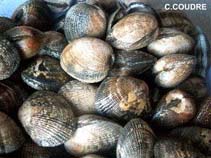Advertisement
Ruditapes decussatus (Linnaeus, 1758)
Grooved carpet shell| Native range | All suitable habitat | Point map | Year 2050 |

|
| This map was computer-generated and has not yet been reviewed. |
| Ruditapes decussatus AquaMaps Data sources: GBIF OBIS |
France country information
Common names:
[No common name]
Occurrence: native
Salinity: marine
Abundance: | Ref:
Importance: | Ref:
Aquaculture: never/rarely | Ref:
Regulations: no regulations | Ref:
Uses: no uses
Comments: Known from Concarneau (Brittany), Thau (Ref. 105868), Sète and Marseille (Ref. 105871) . C: Ref. 105868; M: Ref. 74416.
National Checklist:
Country Information: https://www.cia.gov/library/publications/resources/the-world-factbook/geos/fr.html
National Fisheries Authority:
Occurrences: Occurrences Point map
Main Ref: Poutiers, J.M., 1987
National Database:
Occurrence: native
Salinity: marine
Abundance: | Ref:
Importance: | Ref:
Aquaculture: never/rarely | Ref:
Regulations: no regulations | Ref:
Uses: no uses
Comments: Known from Concarneau (Brittany), Thau (Ref. 105868), Sète and Marseille (Ref. 105871) . C: Ref. 105868; M: Ref. 74416.
National Checklist:
Country Information: https://www.cia.gov/library/publications/resources/the-world-factbook/geos/fr.html
National Fisheries Authority:
Occurrences: Occurrences Point map
Main Ref: Poutiers, J.M., 1987
National Database:
Common names from other countries
Classification / Names Common names | Synonyms | Catalog of Fishes (gen., sp.) | ITIS | CoL | WoRMS
Environment: milieu / climate zone / depth range / distribution range Ecology
Benthic; brackish; depth range 0 - 1 m (Ref. 105875). Tropical, preferred 15°C (Ref. 107945); 61°N - 13°N, 18°W - 36°E
Distribution Countries | FAO areas | Ecosystems | Occurrences | Introductions
Eastern Atlantic and Mediterranean: from Norway to United Kingdom, France, Spain, Portugal, Morocco, Mauritania, and Senegal, including the Mediterranean, from Spain, France, Monaco, Italy, Slovenia, Croatia, Bosnia and Herzegovina, Montenegro, Albania, Greece, Turkey, Cyprus, Syria, Lebanon, Israel Egypt, Libya, Tunisia, and Algeria. Introduced in Azores Islands. Temperate to tropical.
Length at first maturity / Size / Weight / Age
Maturity: Lm ? range ? - ? cm Max length : 8.0 cm SHL male/unsexed; (Ref. 109255); common length : 6.0 cm SHL male/unsexed; (Ref. 437)
Found in sheltered bays, estuaries and lagoons (Ref. 106936). Tends to bury itself in sand, muddy gravel, clay (Ref. 78574) or silty mud (Ref. 107087) and is found on the lower shore and shallow sublittoral (Ref. 78574). Feeds on phytoplankton and detritus (Ref. 107087).
Life cycle and mating behavior Maturity | Reproduction | Spawning | Eggs | Fecundity | Larvae
Members of the class Bivalvia are mostly gonochoric, some are protandric hermaphrodites. Life cycle: Embryos develop into free-swimming trocophore larvae, succeeded by the bivalve veliger, resembling a miniature clam.
Main reference
References | Coordinator | Collaborators
SAUP Database. 2006. (Ref. 356)
IUCN Red List Status
(Ref. 130435: Version 2024-2)
CITES status (Ref. 108899)
Not Evaluated
CMS (Ref. 116361)
Not Evaluated
Human uses
Fisheries: commercial
FAO - Aquaculture: production, species profile; Fisheries: landings, species profile | FishSource | Sea Around Us
Tools
More information
Internet sources
BHL | BOLD Systems | CISTI | DiscoverLife | FAO(Aquaculture: species profile; Fisheries: species profile; publication : search) | GenBank (genome, nucleotide) | GloBI | Gomexsi | Google Books | Google Scholar | Google | PubMed | Tree of Life | Wikipedia (Go, Search) | Zoological Record
Estimates based on models
Preferred temperature
(Ref. 115969): 9.4 - 21.1, mean 18.1 (based on 876 cells).
Resilience
(Ref. 69278)
High, minimum population doubling time less than 15 months (K=0.44-0.52).




